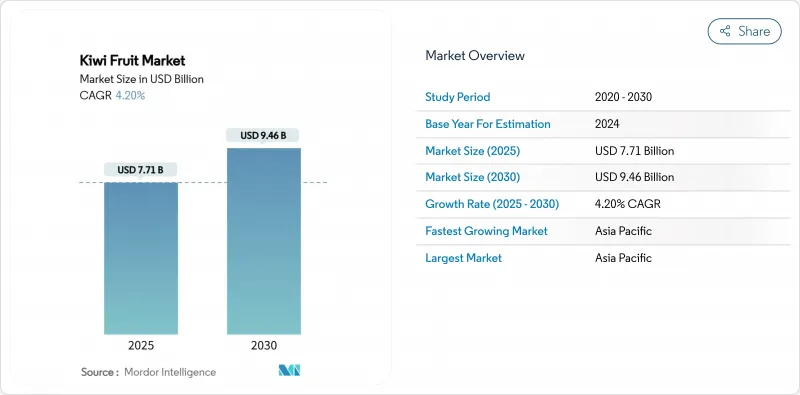
|
市場調査レポート
商品コード
1852023
キウイフルーツ:市場シェア分析、産業動向、統計、成長予測(2025年~2030年)Kiwi Fruit - Market Share Analysis, Industry Trends & Statistics, Growth Forecasts (2025 - 2030) |
||||||
カスタマイズ可能
適宜更新あり
|
|||||||
| キウイフルーツ:市場シェア分析、産業動向、統計、成長予測(2025年~2030年) |
|
出版日: 2025年08月11日
発行: Mordor Intelligence
ページ情報: 英文 120 Pages
納期: 2~3営業日
|
概要
キウイフルーツの市場規模は2025年に77億1,000万米ドルに達し、2030年には94億6,000万米ドルに拡大すると予測されています。

この成長軌道は、消費者がビタミンCを豊富に含む選択肢を優先し、小売業者がプレミアム・グリーン、ゴールド、新興の赤色品種を主流とするにつれて、このカテゴリーがニッチ農産物から中核機能性食品へと移行していることを明確に示しています。2024年に関税が撤廃されるニュージーランドと欧州連合の協定を筆頭とする貿易自由化によって、より価値の高いチャネルが開かれつつあります。高密度の果樹園や台木の矮性化などの技術革新は、1ヘクタールあたりの収量を高め、単価を引き下げる一方、AIを活用したコールドチェーン・ツールは腐敗を減らし、出荷可能な期間を拡大します。耐病性育種プログラムと先進的なバイオコントロールは、PSA細菌キャンカーのリスクを軽減し、投資家の信頼を支え、キウイフルーツ市場の長期的なファンダメンタルズを強化しています。
世界のキウイフルーツ市場の動向と洞察
ビタミンCを豊富に含む果物への需要の高まり
キウイフルーツの優れた栄養密度に対する消費者の意識は、サンゴールド・キウイフルーツを1日2個摂取することで、食物繊維と抗酸化物質をさらに摂取できるとともに、ビタミンC補給の代わりにもなるという臨床研究結果を受け、高まっています。サンゴールド・キウイ2個で1日に必要なビタミンCを摂取できるという臨床研究により、サンゴールド・キウイはサプリメントに代わる自然な果物として位置づけられるようになりました。100gあたり90mgのビタミンCを含むキウイフルーツは、オレンジを凌駕し、免疫機能、消化器系の健康、抗酸化物質の摂取をサポートします。ホールフーズ(Whole Foods)などの小売業者は、キウイフルーツを他の機能性食品と並べて販売することで、この果物の健康志向を強化し、裕福な都市部におけるキウイ市場の世帯普及率を高めています。
商業果樹園の拡大
従来の1ヘクタール当たり15~25トンに対し、高密度のシステムでは20~45トンを収穫できるようになり、利幅が拡大し、中国、イラン、ギリシャでの供給拡大が加速しています。幼果期を短縮する遺伝子編集の画期的な進歩は、さらなる生産量の増加を約束し、生産者に既存面積の転換を促し、キウイ市場の価格を安定させる生産量の増加に拍車をかけています。ゼスプリは、すべてのキウイ・カテゴリーで1ヘクタール当たりの平均収益が過去の記録を上回ると予測しており、拡大への経済的インセンティブは依然として強いです。
PSAによる細菌性カンカーの発生
Pseudomonas syringae pv. actinidiaeは、キウイ産業にとって最も重大な生物学的脅威であり、経済的損失は世界全体で数億米ドルに達しています。抵抗性品種やファージベースのバイオコントロールは進歩しているが、果樹園を守り、キウイ市場への投資家の関心を維持するためには、継続的な監視と品種の更新が必要です。伝統的な育種と新たな遺伝子編集技術によるPseudomonas syringae pv. actinidiae耐性品種の開発は、長期的な解決策を提供するが、実施時期は一般的な投資期間を超えます。
セグメント分析
キウイフルーツ市場レポートは地域別(北米、欧州、アジア太平洋、南米、中東・アフリカ)にセグメント化しています。生産分析(数量)、消費分析(金額と数量)、輸出分析(金額と数量)、輸入分析(金額と数量)、価格動向分析を含みます。市場予測は金額(米ドル)と数量(メトリックトン)で提供されます。
地域分析
2024年のキウイ市場はアジア太平洋が59.6%のシェアを占め、中国の240万トンの生産量と中間層の健康志向の高まりが牽引します。同地域の2030年までのCAGRは8.9%で、都市化の動向と可処分所得の増加を反映しています。特に中国の二次都市では、健康意識の高い中間層の消費者の間でキウイフルーツの採用が加速しています。高価値輸出におけるニュージーランドの優位は続いており、世界のキウイフルーツ貿易シェアの40%を占めています。日本は依然として黄金品種のプレミアム市場であり、インドの新興消費パターンは、コールドチェーンのインフラが発達するにつれて、長期的な成長の大きな可能性を示唆しています。
2024年5月のEU-NZ自由貿易協定(FTA)実施に伴い、欧州がニュージーランド最大のキウイフルーツ市場に浮上し、関税撤廃により価格競争力が一気に向上したため、中国を上回りました。オランダは、キウイフルーツを含むエキゾチック・フルーツの主要エントリー・ポイントとして機能し、確立された物流ネットワークを通じて大陸全域への流通を促進しています。イタリア、スペイン、フランス、ドイツにおける消費者の嗜好調査では、赤パルプの高級品種への関心が高まっていることが明らかになり、従来のグリーンやゴールドを超える継続的なイノベーションに対する市場の準備が整っていることを示唆しています。この地域では持続可能性と有機認証が重視されているため、競争力のある価格設定を維持しながら厳しい環境基準を満たすことができる生産者にはチャンスがあります。
北米は、成熟しつつも進化しつつある地域です。メキシコは北米自由貿易協定(NAFTA)に加盟しており、北米市場全体におけるキウイフルーツの流通を促進しています。この地域が高級品種と有機認証に重点を置いていることは、消費者が品質と健康上の利点を認識するために高い価格を支払う意思を持っていることと一致しています。
その他の特典:
- エクセル形式の市場予測(ME)シート
- 3ヶ月のアナリストサポート
よくあるご質問
目次
第1章 イントロダクション
- 調査の前提条件と市場の定義
- 調査範囲
第2章 調査手法
第3章 エグゼクティブサマリー
第4章 市場情勢
- 市場概要
- 市場促進要因
- ビタミンCの豊富な果物への需要の高まり
- 商業果樹園の拡大
- 健康志向の消費者層の成長
- 貿易自由化により生鮮果実の関税が引き下げられる
- 高密度植栽と台木のイノベーション
- 管理された大気輸送による賞味期限の延長
- 市場抑制要因
- PSAバクテリア・キャンカーの発生
- 新興市場における高いポストハーベスト腐敗性
- 収穫ピーク時の季節的労働力不足
- バイオセキュリティによる突然の輸入禁止
- バリュー/サプライチェーン分析
- 規制情勢
- テクノロジーの展望
- PESTEL分析
第5章 市場規模と成長予測
- 地域別(生産分析、消費分析(数量と金額)、輸入分析(数量と金額)、輸出分析(数量と金額)、価格動向分析)
- 北米
- 米国
- カナダ
- メキシコ
- 南米
- ブラジル
- アルゼンチン
- チリ
- 欧州
- ドイツ
- フランス
- イタリア
- 英国
- アジア太平洋地域
- 中国
- インド
- 日本
- オーストラリア
- 中東
- トルコ
- サウジアラビア
- アフリカ
- 南アフリカ
- ケニア
- エジプト
- 北米
第6章 競合情勢
- List of Stakeholders

